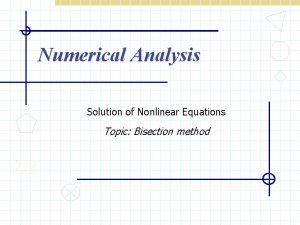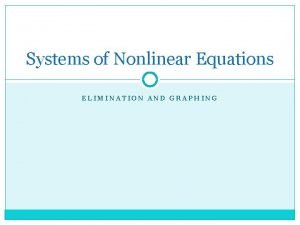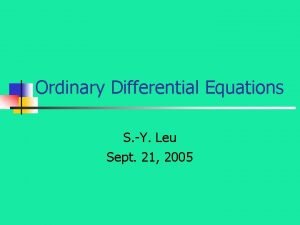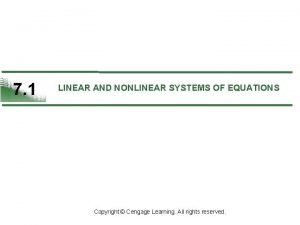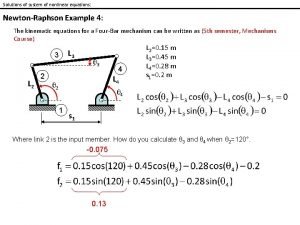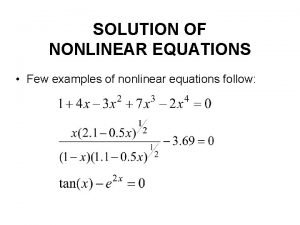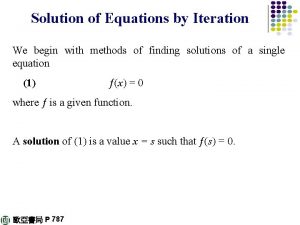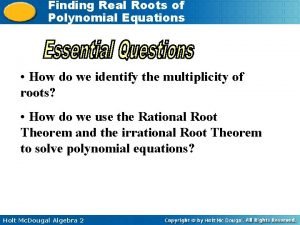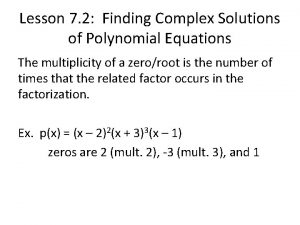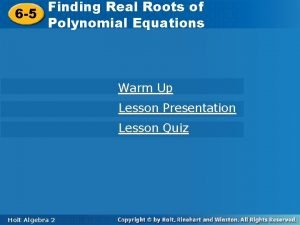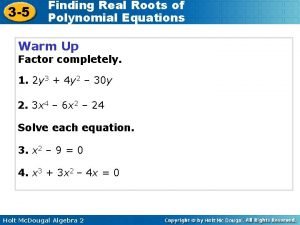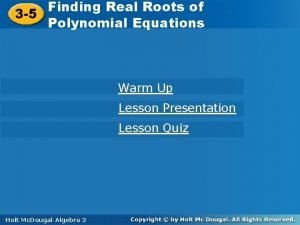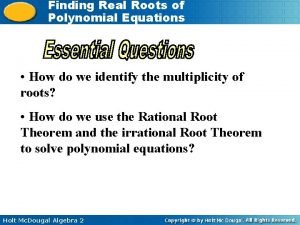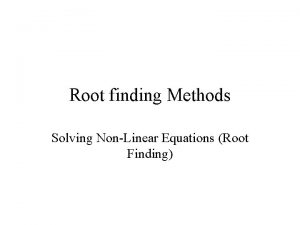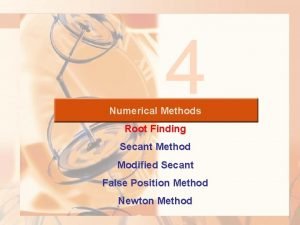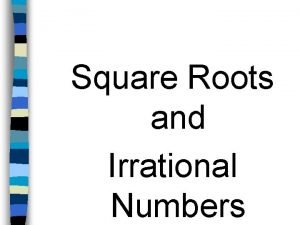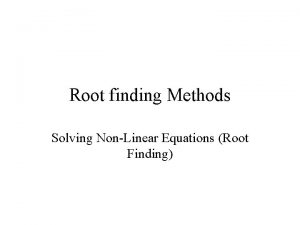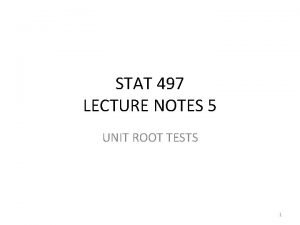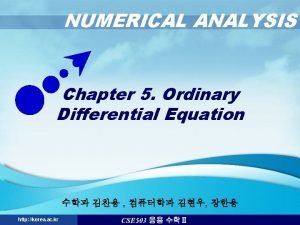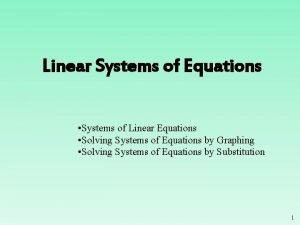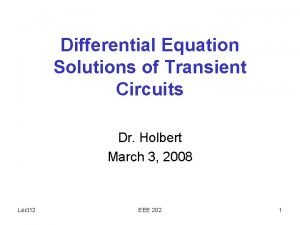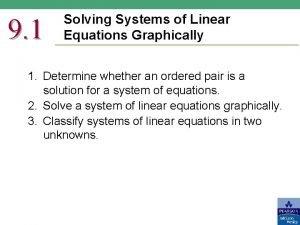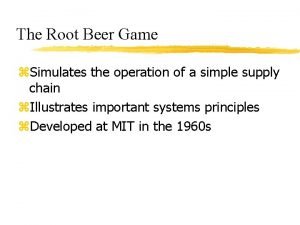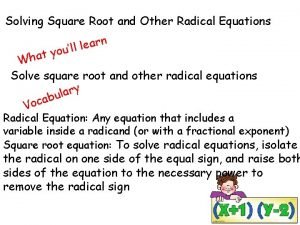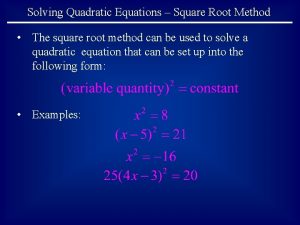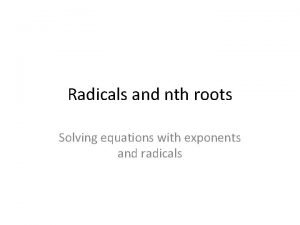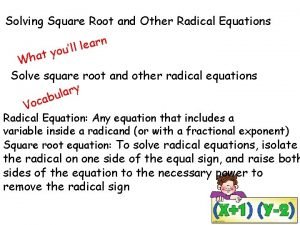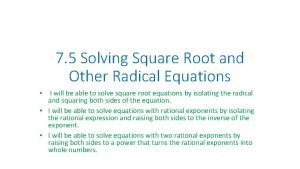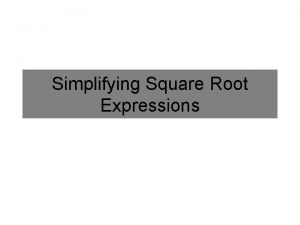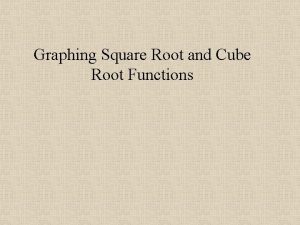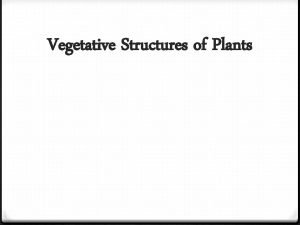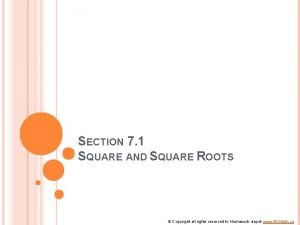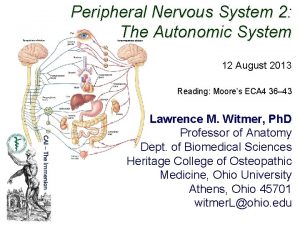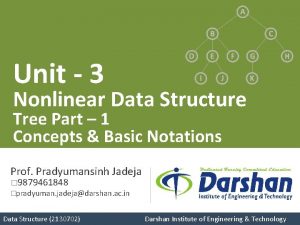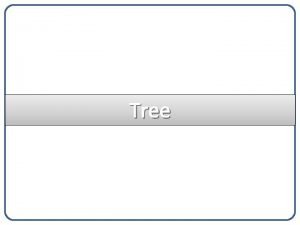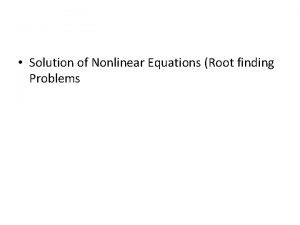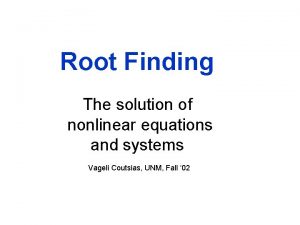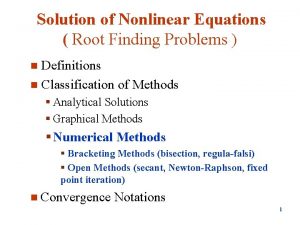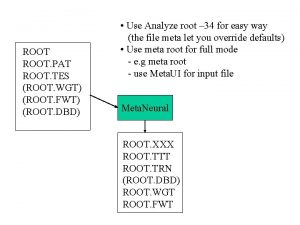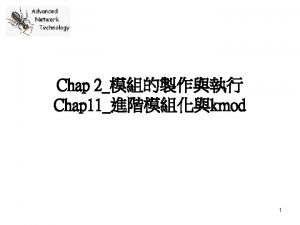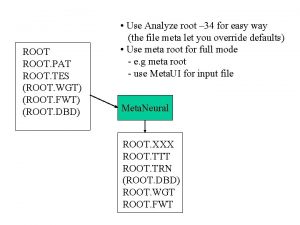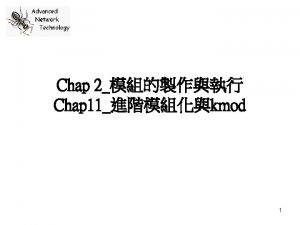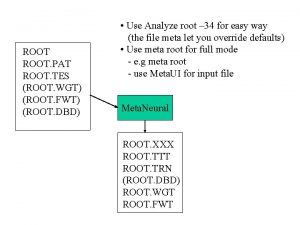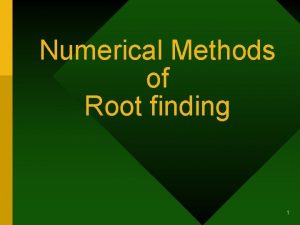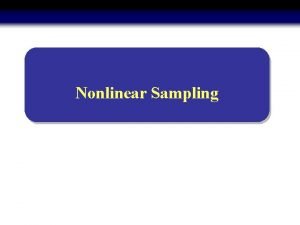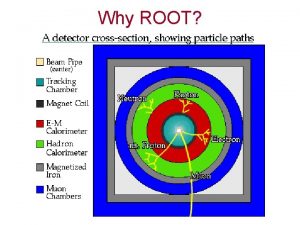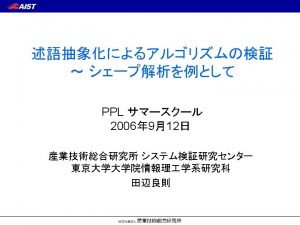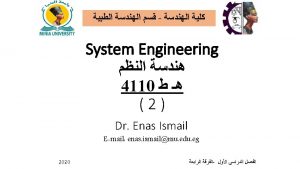Lecture 4 Solution of Nonlinear Equations Root finding





















![Intermediate Value Theorem p p Let f(x) be defined on the interval [a, b], Intermediate Value Theorem p p Let f(x) be defined on the interval [a, b],](https://slidetodoc.com/presentation_image_h2/772b341fe4606afdf8dda157fa4d8e25/image-22.jpg)


![Bisection Method p If the function is continuous on [a, b] and f(a) and Bisection Method p If the function is continuous on [a, b] and f(a) and](https://slidetodoc.com/presentation_image_h2/772b341fe4606afdf8dda157fa4d8e25/image-25.jpg)
![Bisection Algorithm Assumptions: p f(x) is continuous on [a, b] p f(a) f(b) < Bisection Algorithm Assumptions: p f(x) is continuous on [a, b] p f(a) f(b) <](https://slidetodoc.com/presentation_image_h2/772b341fe4606afdf8dda157fa4d8e25/image-26.jpg)
![Bisection Method Assumptions: Given an interval [a, b] f(x) is continuous on [a, b] Bisection Method Assumptions: Given an interval [a, b] f(x) is continuous on [a, b]](https://slidetodoc.com/presentation_image_h2/772b341fe4606afdf8dda157fa4d8e25/image-27.jpg)

















![Summary of Solution Initial interval containing the root [0. 5, 0. 9] p After Summary of Solution Initial interval containing the root [0. 5, 0. 9] p After](https://slidetodoc.com/presentation_image_h2/772b341fe4606afdf8dda157fa4d8e25/image-45.jpg)




- Slides: 49

Lecture 4 Solution of Nonlinear Equations ( Root finding Problems ) Definitions n. Examples n Classification of methods n p p p Analytical solutions Graphical methods Numerical methods § Bracketing methods § Open methods n EE 3561_Unit 2 Convergence Notations Reading Assignment: Sections 5. 1 and 5. 2 (c)AL-DHAIFALLAH 1435 1

Root finding Problems Many problems in Science and Engineering are expressed as These problems are called root finding problems EE 3561_Unit 2 (c)AL-DHAIFALLAH 1435 2

Roots of Equations A number r that satisfies an equation is called a root of the equation. EE 3561_Unit 2 (c)AL-DHAIFALLAH 1435 3

Zeros of a function Let f(x) be a real-valued function of a real variable. Any number r for which f(r)=0 is called a zero of the function. Examples: 2 and 3 are zeros of the function f(x) = (x-2)(x-3) EE 3561_Unit 2 (c)AL-DHAIFALLAH 1435 4

Graphical Interpretation of zeros p The real zeros of a function f(x) are the values of x at which the graph of the function crosses (or touches ) the x-axis. f(x) Real zeros of f(x) EE 3561_Unit 2 (c)AL-DHAIFALLAH 1435 5

Multiple zeros EE 3561_Unit 2 (c)AL-DHAIFALLAH 1435 6

Multiple Zeros EE 3561_Unit 2 (c)AL-DHAIFALLAH 1435 7

Simple Zeros EE 3561_Unit 2 (c)AL-DHAIFALLAH 1435 8

Facts Any nth order polynomial has exactly n zeros (counting real and complex zeros with their multiplicities). p Any polynomial with an odd order has at least one real zero. p If a function has a zero at x=r with multiplicity m then the function and its first (m-1) derivatives are zero at x=r and the mth derivative at r is not zero. p EE 3561_Unit 2 (c)AL-DHAIFALLAH 1435 9

Roots of Equations & Zeros of function EE 3561_Unit 2 (c)AL-DHAIFALLAH 1435 10

Solution Methods Several ways to solve nonlinear equations are possible. p Analytical Solutions n p Graphical Solutions n p possible for special equations only Useful for providing initial guesses for other methods Numerical Solutions n n Open methods Bracketing methods EE 3561_Unit 2 (c)AL-DHAIFALLAH 1435 11

Solution Methods: Analytical Solutions are available for special equations only. EE 3561_Unit 2 (c)AL-DHAIFALLAH 1435 12

Graphical Methods p Graphical methods are useful to provide an initial guess to be used by other methods 2 Root 1 1 EE 3561_Unit 2 (c)AL-DHAIFALLAH 1435 2 13

Bracketing Methods In bracketing methods, the method starts with an interval that contains the root and a procedure is used to obtain a smaller interval containing the root. p Examples of bracketing methods : p n n Bisection method False position method EE 3561_Unit 2 (c)AL-DHAIFALLAH 1435 14

Open Methods In the open methods, the method starts with one or more initial guess points. In each iteration a new guess of the root is obtained. p Open methods are usually more efficient than bracketing methods p They may not converge to a root. p EE 3561_Unit 2 (c)AL-DHAIFALLAH 1435 15

Solution Methods Many methods are available to solve nonlinear equations q Bisection Method q Newton’s Method These will be covered in EE 3561 q Secant Method n False position Method n Muller’s Method n Bairstow’s Method n Fixed point iterations n ………. EE 3561_Unit 2 (c)AL-DHAIFALLAH 1435 16

Convergence Notation EE 3561_Unit 2 (c)AL-DHAIFALLAH 1435 17

Convergence Notation EE 3561_Unit 2 (c)AL-DHAIFALLAH 1435 18

Speed of convergence We can compare different methods in terms of their convergence rate. p Quadratic convergence is faster than linear convergence. p A method with convergence order q converges faster than a method with convergence order p if q>p. p A Method of convergence order p>1 are said to have super linear convergence. p EE 3561_Unit 2 (c)AL-DHAIFALLAH 1435 19

Bisection Method n n n The Bisection Algorithm Convergence Analysis of Bisection Method Examples Reading Assignment: EE 3561_Unit 2 Sections 5. 1 and 5. 2 (c)AL-DHAIFALLAH 1435 20

Introduction: p p p The Bisection method is one of the simplest methods to find a zero of a nonlinear function. It is also called interval halving method. To use the Bisection method, one needs an initial interval that is known to contain a zero of the function. The method systematically reduces the interval. It does this by dividing the interval into two equal parts, performs a simple test and based on the result of the test half of the interval is thrown away. The procedure is repeated until the desired interval size is obtained. EE 3561_Unit 2 (c)AL-DHAIFALLAH 1435 21
![Intermediate Value Theorem p p Let fx be defined on the interval a b Intermediate Value Theorem p p Let f(x) be defined on the interval [a, b],](https://slidetodoc.com/presentation_image_h2/772b341fe4606afdf8dda157fa4d8e25/image-22.jpg)
Intermediate Value Theorem p p Let f(x) be defined on the interval [a, b], Intermediate value theorem: if a function is continuous and f(a) and f(b) have different signs then the function has at least one zero in the interval [a, b] EE 3561_Unit 2 (c)AL-DHAIFALLAH 1435 f(a) a b f(b) 22

Examples p p If f(a) and f(b) have the same sign, the function may have an even number of real zeros or no real zero in the interval [ a, b] Bisection method can not be used in these cases a b The function has four real zeros a b The function has no real zeros EE 3561_Unit 2 (c)AL-DHAIFALLAH 1435 23

Two more Examples If f(a) and f(b) have different signs, the function has at least one real zero p Bisection method can be used to find one of the zeros. p a b The function has one real zero a b The function has three real zeros EE 3561_Unit 2 (c)AL-DHAIFALLAH 1435 24
![Bisection Method p If the function is continuous on a b and fa and Bisection Method p If the function is continuous on [a, b] and f(a) and](https://slidetodoc.com/presentation_image_h2/772b341fe4606afdf8dda157fa4d8e25/image-25.jpg)
Bisection Method p If the function is continuous on [a, b] and f(a) and f(b) have different signs, Bisection Method obtains a new interval that is half of the current interval and the sign of the function at the end points of the interval are different. p This allows us to repeat the Bisection procedure to further reduce the size of the interval. EE 3561_Unit 2 (c)AL-DHAIFALLAH 1435 25
![Bisection Algorithm Assumptions p fx is continuous on a b p fa fb Bisection Algorithm Assumptions: p f(x) is continuous on [a, b] p f(a) f(b) <](https://slidetodoc.com/presentation_image_h2/772b341fe4606afdf8dda157fa4d8e25/image-26.jpg)
Bisection Algorithm Assumptions: p f(x) is continuous on [a, b] p f(a) f(b) < 0 Algorithm: Loop 1. Compute the mid point c=(a+b)/2 2. Evaluate f(c ) 3. If f(a) f(c) < 0 then new interval [a, c] If f(a) f( c) > 0 then new interval [c, b] End loop EE 3561_Unit 2 (c)AL-DHAIFALLAH 1435 f(a) c b a f(b) 26
![Bisection Method Assumptions Given an interval a b fx is continuous on a b Bisection Method Assumptions: Given an interval [a, b] f(x) is continuous on [a, b]](https://slidetodoc.com/presentation_image_h2/772b341fe4606afdf8dda157fa4d8e25/image-27.jpg)
Bisection Method Assumptions: Given an interval [a, b] f(x) is continuous on [a, b] f(a) and f(b) have opposite signs. These assumptions ensures the existence of at least one zero in the interval [a, b] and the bisection method can be used to obtain a smaller interval that contains the zero. EE 3561_Unit 2 (c)AL-DHAIFALLAH 1435 27

Bisection Method b 0 a 0 EE 3561_Unit 2 a 1 a 2 (c)AL-DHAIFALLAH 1435 28

Example + + - + + EE 3561_Unit 2 (c)AL-DHAIFALLAH 1435 - + - - 29

Flow chart of Bisection Method Start: Given a, b and ε u = f(a) ; v = f(b) c = (a+b) /2 ; w = f(c) yes b=c; v= w EE 3561_Unit 2 is no u w <0 no is (b-a) /2<ε yes Stop a=c; u= w (c)AL-DHAIFALLAH 1435 30

Example Answer: EE 3561_Unit 2 (c)AL-DHAIFALLAH 1435 31

Example: Answer: EE 3561_Unit 2 (c)AL-DHAIFALLAH 1435 32

Best Estimate and error level Bisection method obtains an interval that is guaranteed to contain a zero of the function Questions: p p What is the best estimate of the zero of f(x)? What is the error level in the obtained estimate? EE 3561_Unit 2 (c)AL-DHAIFALLAH 1435 33

Best Estimate and error level The best estimate of the zero of the function is the mid point of the last interval generated by the Bisection method. EE 3561_Unit 2 (c)AL-DHAIFALLAH 1435 34

Stopping Criteria Two common stopping criteria 1. 2. Stop after a fixed number of iterations Stop when the absolute error is less than a specified value How these criteria are related? EE 3561_Unit 2 (c)AL-DHAIFALLAH 1435 35

Stopping Criteria EE 3561_Unit 2 (c)AL-DHAIFALLAH 1435 36

Convergence Analysis EE 3561_Unit 2 (c)AL-DHAIFALLAH 1435 37

Convergence Analysis Alternative form EE 3561_Unit 2 (c)AL-DHAIFALLAH 1435 38

Example EE 3561_Unit 2 (c)AL-DHAIFALLAH 1435 39

Example p Use Bisection method to find a root of the equation x = cos (x) with absolute error <0. 02 (assume the initial interval [0. 5, 0. 9]) Question EE 3561_Unit 2 1: 2: 3: 4: What is f (x) ? Are the assumptions satisfied ? How many iterations are needed ? How to compute the new estimate ? (c)AL-DHAIFALLAH 1435 40

EE 3561_Unit 2 (c)AL-DHAIFALLAH 1435 41

Bisection Method Initial Interval f(a)=-0. 3776 a =0. 5 EE 3561_Unit 2 f(b) =0. 2784 c= 0. 7 b= 0. 9 (c)AL-DHAIFALLAH 1435 42

Example Steps 1 and 2 -0. 3776 0. 5 -0. 0648 0. 7 EE 3561_Unit 2 -0. 0648 0. 2784 0. 7 0. 1033 Error < 0. 1 0. 9 0. 2784 0. 8 (c)AL-DHAIFALLAH 1435 Error < 0. 05 0. 9 43

Example Steps 3 and 4 -0. 0648 0. 70 EE 3561_Unit 2 0. 0183 0. 1033 0. 75 0. 8 -0. 0235 0. 0183 0. 725 (c)AL-DHAIFALLAH 1435 Error < 0. 025 Error <. 0125 0. 75 44
![Summary of Solution Initial interval containing the root 0 5 0 9 p After Summary of Solution Initial interval containing the root [0. 5, 0. 9] p After](https://slidetodoc.com/presentation_image_h2/772b341fe4606afdf8dda157fa4d8e25/image-45.jpg)
Summary of Solution Initial interval containing the root [0. 5, 0. 9] p After 4 iterations p n n n Interval containing the root [0. 725 , 0. 75] Best estimate of the root is 0. 7375 | Error | < 0. 0125 EE 3561_Unit 2 (c)AL-DHAIFALLAH 1435 45

Programming Bisection Method c= 0. 7000 fc = -0. 0648 c= 0. 8000 fc = 0. 1033 c= 0. 7500 fc = 0. 0183 c= 0. 7250 fc = -0. 0235 a=. 5; b=. 9; u=a-cos(a); v= b-cos(b); for i=1: 5 c=(a+b)/2 fc=c-cos(c) if u*fc<0 b=c ; v=fc; else a=c; u=fc; end EE 3561_Unit 2 (c)AL-DHAIFALLAH 1435 46

Example Find the root of EE 3561_Unit 2 (c)AL-DHAIFALLAH 1435 47

Example Iteration a b c= (a+b) 2 f(c) (b-a) 2 0 0 1 0. 5 -0. 375 0. 5 1 0 0. 5 0. 266 0. 25 2 0. 25 0. 5 . 375 -7. 23 E-3 0. 125 3 0. 25 0. 375 0. 3125 9. 30 E-2 0. 0625 4 0. 3125 0. 375 0. 34375 9. 37 E-3 0. 03125 EE 3561_Unit 2 (c)AL-DHAIFALLAH 1435 48

Bisection Method Advantages p Simple and easy to implement p One function evaluation per iteration p The size of the interval containing the zero is reduced by 50% after each iteration p The number of iterations can be determined a priori p No knowledge of the derivative is needed p The function does not have to be differentiable Disadvantage p Slow to converge p Good intermediate approximations may be discarded EE 3561_Unit 2 (c)AL-DHAIFALLAH 1435 49
 Bisection method solved examples
Bisection method solved examples Nonlinear regression lecture notes
Nonlinear regression lecture notes 01:640:244 lecture notes - lecture 15: plat, idah, farad
01:640:244 lecture notes - lecture 15: plat, idah, farad Graphing nonlinear equations
Graphing nonlinear equations First order differential equation formula
First order differential equation formula How to tell if a table is linear
How to tell if a table is linear Difference between linear and nonlinear equation
Difference between linear and nonlinear equation Nonlinear systems of equations worksheet
Nonlinear systems of equations worksheet Nonlinear equations
Nonlinear equations Solving simultaneous equations graphically worksheet
Solving simultaneous equations graphically worksheet Eliminasi gauss naif
Eliminasi gauss naif What is a nonlinear equation
What is a nonlinear equation Secant method nonlinear equations
Secant method nonlinear equations Finding real roots of polynomial equations
Finding real roots of polynomial equations 7.2 finding complex solutions of polynomial equations
7.2 finding complex solutions of polynomial equations Finding real roots
Finding real roots Finding real roots of polynomial equations
Finding real roots of polynomial equations Finding real roots of polynomial equations
Finding real roots of polynomial equations Finding real roots of polynomial equations
Finding real roots of polynomial equations Muller method solved example
Muller method solved example Open method and bracketing method
Open method and bracketing method Secant method example
Secant method example All square roots are irrational numbers
All square roots are irrational numbers What is root finding
What is root finding Unit root time series
Unit root time series Ideal solution and non ideal solution
Ideal solution and non ideal solution Transient solution differential equations
Transient solution differential equations Graph inconsistent
Graph inconsistent Pde
Pde Natural solution
Natural solution One solution
One solution The root beer game
The root beer game Polar and rectangular forms of equations
Polar and rectangular forms of equations Translate word equations to chemical equations
Translate word equations to chemical equations Equation for square root
Equation for square root Root of an equation
Root of an equation Root of an equation
Root of an equation Root of equation
Root of equation Solving square root and other radical equations
Solving square root and other radical equations Squre root
Squre root Types of roots
Types of roots Bound root + free root
Bound root + free root Graphing cube root functions
Graphing cube root functions Vegetative structure
Vegetative structure Square table 1 to 30
Square table 1 to 30 The difference between sympathetic and parasympathetic
The difference between sympathetic and parasympathetic Subthalamus
Subthalamus Linear and nonlinear data structure
Linear and nonlinear data structure Linear editing vs non linear editing
Linear editing vs non linear editing Linear and nonlinear data structure
Linear and nonlinear data structure
